

Quantum Mechanics: Wikipedia articles. CERN & the LHC. The Higgs boson. Nothingness. How Quantum Physics affects our Ideas of Reality. Physicists Discover New Massless Particle; Could Revolutionize Electronics & Quantum Computing. Hasan pictured with a scanning tunneling spectromicroscope used to find the Weyl fermion.

Danielle Alio/Princeton University. Physics may have just taken a new leap forward, as three independent groups of physicists have found strong evidence for massless particles called “Weyl fermions,” which exist as quasiparticles – collective excitations of electrons. Ultimately, this discovery is over 80 years in the making, dating back to Paul Dirac. In 1928, Dirac came up with an equation that described the spin of fermions (fermions are the building blocks that make up all matter). After 85-year search, massless particle with promise for next-generation electronics found. An international team led by Princeton University scientists has discovered Weyl fermions, an elusive massless particle theorized 85 years ago.

The particle could give rise to faster and more efficient electronics because of its unusual ability to behave as matter and antimatter inside a crystal, according to new research. The researchers report in the journal Science July 16 the first observation of Weyl fermions, which, if applied to next-generation electronics, could allow for a nearly free and efficient flow of electricity in electronics, and thus greater power, especially for computers, the researchers suggest. Proposed by the mathematician and physicist Hermann Weyl in 1929, Weyl fermions have been long sought by scientists because they have been regarded as possible building blocks of other subatomic particles, and are even more basic than the ubiquitous, negative-charge carrying electron (when electrons are moving inside a crystal).
New Discovery in Particle Physics Raises Hope for a "Theory of Everything" The standard model of particle physics, which describes every particle we know of and how they interact, was given much credence when the Higgs boson was discovered in 2012.
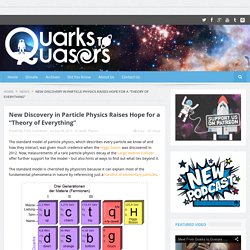
Now, measurements of a rare particle-physics decay at the Large Hadron Collider offer further support for the model – but also hints at ways to find out what lies beyond it. The standard model is cherished by physicists because it can explain most of the fundamental phenomena in nature by referencing just a handful of elementary particles. The elementary particles that according to the standard model makes up matter. By HolgerFiedler nach Benutzer:Murphee via Wikimedia Commons, CC BY-SA These particles include quarks (one of the components of an atom) and electron-like particles called leptons – along with their so-called antiparticles which are identical but have opposite charge.
Even the sun has spots… Carver Mead's Spectator Interview. From American Spectator, Sep/Oct2001, Vol. 34 Issue 7, p68.

Forget the Higgs, neutrinos may be the key to breaking the Standard Model. Some physicists are surprised that two relatively recent discoveries in their field have captured so much widespread attention: cosmic inflation, the ballooning expansion of the baby universe, and the Higgs boson, which endows other particles with mass.
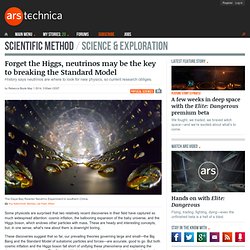
These are heady and interesting concepts, but, in one sense, what's new about them is downright boring. These discoveries suggest that so far, our prevailing theories governing large and small—the Big Bang and the Standard Model of subatomic particles and forces—are accurate, good to go. But both cosmic inflation and the Higgs boson fall short of unifying these phenomena and explaining the deepest cosmic questions. Scientists stop light completely for a record-breaking MINUTE by trapping it inside a crystal. By Abigail Frymann Published: 15:39 GMT, 27 July 2013 | Updated: 15:39 GMT, 27 July 2013 Scientists in Germany have succeeded in stopping light - the fastest thing in the universe - for a whole minute, smashing earlier records.
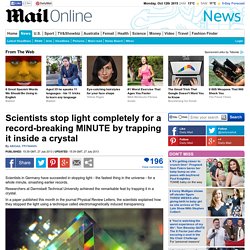
Researchers at Darmstadt Technical University achieved the remarkable feat by trapping it in a crystal. In a paper published this month in the journal Physical Review Letters, the scientists explained how they stopped the light using a technique called electromagnetically induced transparency. Crystal clear: scientists found they could trap light inside a crystal for up to sixty seconds At full pelt, light would normally travel about 11 million miles in one minute – equivalent to more than 20 round trips to the moon.
A Mass-less Minute. The reins of Casimir: Engineered nanostructures could offer way to control quantum effect. You might think that a pair of parallel plates hanging motionless in a vacuum just a fraction of a micrometer away from each other would be like strangers passing in the night—so close but destined never to meet.
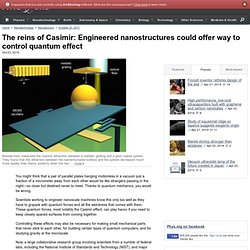
Thanks to quantum mechanics, you would be wrong. Scientists working to engineer nanoscale machines know this only too well as they have to grapple with quantum forces and all the weirdness that comes with them. These quantum forces, most notably the Casimir effect, can play havoc if you need to keep closely spaced surfaces from coming together. Controlling these effects may also be necessary for making small mechanical parts that never stick to each other, for building certain types of quantum computers, and for studying gravity at the microscale. But as often happens with quantum phenomena, the work raises new questions even as it answers others. One of the insights of quantum mechanics is that no space, not even outer space, is ever truly empty.
Recent study reduces Casimir force to lowest recorded level. (Phys.org) —A research team that includes a physics professor at Indiana University-Purdue University Indianapolis (IUPUI) has recorded a drastically reduced measurement of the Casimir effect, a fundamental quantum phenomenon experienced between two neutral bodies that exist in a vacuum.
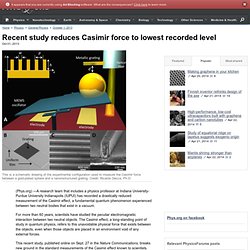
For more than 60 years, scientists have studied the peculiar electromagnetic interaction between two neutral objects. Researchers produce the first experimental pulse-generation of a single electron—a leviton. (Phys.org) —A team of researchers in France has produced the first experimental pulse-generation of a single electron—they've named it a leviton, in honor of physicist Leonid Levitov and its resemblance to a soliton.
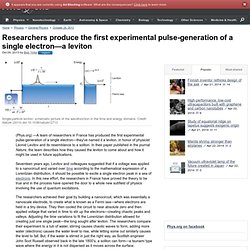
In their paper published in the journal Nature, the team describes how they caused the leviton to come about and how it might be used in future applications. What are quantum computers good for? Security intelligence for a faster world The problem with trying to explain quantum computing to the public is that you end up either simplifying the story so far as to make it wrong, or running down so many metaphorical rabbit-burrows that you end up wrong.

So The Register is going to try and invert the usual approach, and try to describe quantum computing at a more materialistic level: how do you build one, and when it’s built, how do you use it? Hopefully, a concrete framework will make it easier to understand quantum computing along the way. 'One real mystery of quantum mechanics': Physicists devise new experiment. What is light made of: waves or particles? This basic question has fascinated physicists since the early days of science. Quantum mechanics predicts that photons, particles of light, are both particles and waves simultaneously.
Researchers use teleportation to beam a single photon 97km. Team send a single proton 97km in China, while a second team in the Canary Islands claims to have reached 143kmBreakthrough could lead to ultra fast communication systems By Mark Prigg Published: 17:43 GMT, 10 August 2012 | Updated: 17:56 GMT, 10 August 2012 Two teams of researchers have extended the reach of quantum teleportation to unprecedented lengths. What next after the Higgs? Scientists use 1km cube buried 8000ft under South Pole to track down ANOTHER mystery particle. World's biggest telescope to hunt for mysterious 'neutrinos'Particles could help explain origin of universeMega-detector built 8,000ft under ice near South PoleMachine took 10 years to build By Rob Waugh Published: 11:25 GMT, 10 July 2012 | Updated: 12:49 GMT, 10 July 2012.
Scientists photograph shadow of a single atom for the first time. Could allow for medical scans without harmful X-raysSmallest possible object that can be photographed with visible lightShadow photograph took five years By Rob Waugh Published: 10:04 GMT, 5 July 2012 | Updated: 10:12 GMT, 5 July 2012. Scientist unlocks the quantum secrets of the moon's bizarre soil, which hangs suspended above the surface when touched. Soil would hang above the surface, withstand heat - and would stick to astronauts like glue. The matter that's not not not there. Quantum interference of large organic molecules : Nature Communications. Experimental setup. #17: Quantum Weirdness Enters the Larger World. An octopus-shaped molecule is giving Schrödinger’s cat competition as the mascot of the bizarre world of quantum physics, where matter can simultaneously exist in different states. Quantum World.